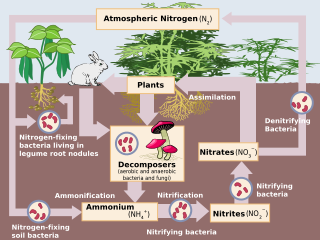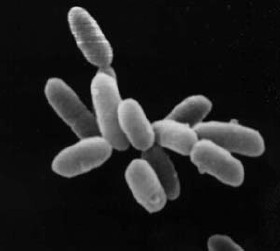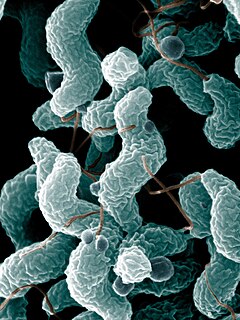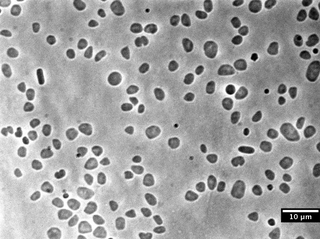
Denitrification is a microbially facilitated process where nitrate (NO3−) is reduced and ultimately produces molecular nitrogen (N2) through a series of intermediate gaseous nitrogen oxide products. Facultative anaerobic bacteria perform denitrification as a type of respiration that reduces oxidized forms of nitrogen in response to the oxidation of an electron donor such as organic matter. The preferred nitrogen electron acceptors in order of most to least thermodynamically favorable include nitrate (NO3−), nitrite (NO2−), nitric oxide (NO), nitrous oxide (N2O) finally resulting in the production of dinitrogen (N2) completing the nitrogen cycle. Denitrifying microbes require a very low oxygen concentration of less than 10%, as well as organic C for energy. Since denitrification can remove NO3−, reducing its leaching to groundwater, it can be strategically used to treat sewage or animal residues of high nitrogen content. Denitrification can leak N2O, which is an ozone-depleting substance and a greenhouse gas that can have a considerable influence on global warming.

Halobacterium is a genus in the family Halobacteriaceae.

Campylobacterota are a phylum of bacteria. All species of this phylum are Gram-negative.
Paracoccus denitrificans, is a coccoid bacterium known for its nitrate reducing properties, its ability to replicate under conditions of hypergravity and for being a relative of the eukaryotic mitochondrion.
In taxonomy, Haloferax is a genus of the Haloferacaceae.
Nisaea is a genus in the phylum Pseudomonadota (Bacteria), which contains two species, namely N. denitrificans and N. nitritireducens, which were described in 2008.
Sulfurimonas is a bacterial genus within the class of Campylobacterota, known for reducing nitrate, oxidizing both sulfur and hydrogen, and containing Group IV hydrogenases. This genus consists of four species: Sulfurimonas autorophica, Sulfurimonas denitrificans, Sulfurimonas gotlandica, and Sulfurimonas paralvinellae. The genus' name is derived from "sulfur" in Latin and "monas" from Greek, together meaning a “sulfur-oxidizing rod”. The size of the bacteria varies between about 1.5-2.5 μm in length and 0.5-1.0 μm in width. Members of the genus Sulfurimonas are found in a variety of different environments which include deep sea-vents, marine sediments, and terrestrial habitats. Their ability to survive in extreme conditions is attributed to multiple copies of one enzyme. Phylogenetic analysis suggests that members of the genus Sulfurimonas have limited dispersal ability and its speciation was affected by geographical isolation rather than hydrothermal composition. Deep ocean currents affect the dispersal of Sulfurimonas spp., influencing its speciation. As shown in the MLSA report of deep-sea hydrothermal vents Campylobacterota, Sulfurimonas has a higher dispersal capability compared with deep sea hydrothermal vent thermophiles, indicating allopatric speciation.
Brachymonas denitrificans is a nonmotile, Gram-negative, aerobic, chemo-organotrophic bacterium from the genus Brachymonas and family Comamonadaceae. B. denitrificans has no flagella and its colonies are cream to pale yellow.
Paraburkholderia denitrificans is a gram-negative, bacterium from the genus Paraburkholderia and the family Burkholderiaceae which was isolated from wet forest soil on the island of Liancourt Rocks. Paraburkholderia denitrificans has the ability to reduced nitrate to nitrogen gas.
Alcaligenes denitrificans is a Gram-negative, oxidase- and catalase-positive, strictly aerobic, motile bacterium with peritrichous flagella, from the genus Alcaligenes. Based on 16S rDNA sequence analysis and the low degree of DNA relatedness between other members of Achromobacter species, Yabuuchi et al propose that Alcaligenes denitrificans should be classified as a subspecies of Achromobacter xylosoxidans.
Roseobacter denitrificans is a species of aerobic pink-pigmented bacteria. It contains Bacteriochlorophyll a. It contains spheroidenone, does not synthesize bacteriochlorophyll anaerobically, but shows aerobic phototrophic activity. Cells are ovoid or rod-shaped and motile by subpolar flagella. R. litoralis does not reduce nitrate, while R. denitrificans does.

Haloferax volcanii is a species of organism in the genus Haloferax in the Archaea.
Flavobacterium denitrificans is a species of N2O-producing facultative aerobic bacteria first isolated from the gut of the earthworm Aporrectodea caliginosa. It is a Gram-negative, motile rod with type strain ED5T (=DSM 15936T =ATCC BAA-842T).
Haloferax larsenii is a gram-negative, aerobic, neutrophilic, extremely halophilic archaeon. It was named in honor of Professor Helge Larsen, who pioneered research on halophiles.
Thiohalorhabdus is a Gram-negative, extremely halophilic and non-motile genus of bacteria from the class Gammaproteobacteria with one known species. Thiohalorhabdus denitrificans has been isolated from sediments from a hypersaline lake from Siberia in Russia.
Defluviimonas denitrificans is a Gram-negative, chemoheterotrophic and moderately halophilic bacterium from the genus of Defluviimonas which has been isolated from a biofilter of a marine aquaculture system in Rehovot in Israel.
Halospina is an extremely halophilic genus of bacteria from the family of Hahellaceae with one known species. Halospina denitrificans has been isolated from sediments from a hypersaline lake.
Prolixibacter denitrificans is a facultatively anaerobic and nitrate-reducing bacterium from the genus of Prolixibacter which has been isolated from isolated from crude oil.
Halovibrio denitrificans is an extremely halophilic and denitrifying bacterium from the genus of Halovibrio which has been isolated from sediments from a hypersaline lake from Central Asia.
Haloferacales is an order of halophilic, chemoorganotrophic or heterotrophic archaea within the class Haloarchaea. The type genus of this order is Haloferax.



